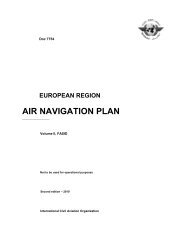7754 Vol 1 Flyleaf - ICAO Public Maps
7754 Vol 1 Flyleaf - ICAO Public Maps
7754 Vol 1 Flyleaf - ICAO Public Maps
You also want an ePaper? Increase the reach of your titles
YUMPU automatically turns print PDFs into web optimized ePapers that Google loves.
CNS IV-11<br />
f) The increasing use of surveillance data<br />
onboard of ‘ADS-B In’ equipped aircraft<br />
to support Air Traffic Situational<br />
Awareness (ATSAW) and spacing<br />
applications and later separation<br />
applications. This also allows for<br />
increased delegation of responsibility for<br />
separation to the flight crew.<br />
FREQUENCY MANAGEMENT<br />
Planning Considerations<br />
General<br />
103. Frequency assignment planning in the EUR region<br />
should be carried out in accordance with the provisions of<br />
Annex 10 supplemented, as necessary, by regional<br />
recommendations and technical criteria developed for this<br />
purpose. Detailed guidance on frequency assignment<br />
planning for AMS and radio navigation aids are contained in<br />
<strong>ICAO</strong> EUR Frequency Management Manual Doc 011.<br />
AMS<br />
104. Frequencies should be assigned to all VHF AMS<br />
facilities, taking into account:<br />
a) agreed geographical separation criteria<br />
based on 8.33 kHz interleaving between<br />
channels for the area where this channel<br />
spacing is applicable;<br />
b) agreed geographical separation criteria<br />
based on 25 kHz interleaving between<br />
channels;<br />
c) agreed geographical separation criteria for<br />
the implementation of VDL services;<br />
d) the need for maximum economy in<br />
frequency demands and in radio spectrum<br />
utilization; and<br />
e) A deployment of frequencies which<br />
ensures that international services are<br />
planned to be free of interference from<br />
other services using the same band.<br />
105. The priority order to be followed in the assignment of<br />
frequencies to service is:<br />
a) ATS channels serving international<br />
services (ACC, APP, TWR, FIS);<br />
b) ATS channels serving national purposes;<br />
c) channels serving international VOLMET<br />
services;<br />
d) channels serving ATIS and PAR; and<br />
e) channels used for other than ATS<br />
purposes.<br />
106. The criteria used for frequency assignment planning for<br />
VHF AMS facilities serving international requirements<br />
should, to the extent practicable, also be used to satisfy the<br />
need of national VHF AMS facilities.<br />
107. Special provisions should be made, by agreement<br />
between the States concerned, for the sharing and the<br />
application of reduced protection of non-ATC frequencies in<br />
the national sub-bands, so as to obtain a more economical use<br />
of the available frequency spectrum consistent with<br />
operational requirements.<br />
108. It should be ensured that no air/ground frequency is<br />
utilized outside its designated operational coverage.<br />
109. It should be ensured that the stated operational<br />
requirements for coverage of a given frequency can be met<br />
for the transmission sites concerned, taking into account<br />
terrain configuration.<br />
Radio navigation aids<br />
110. Frequencies should be assigned to all radio navigation<br />
facilities taking into account:<br />
a) agreed geographical separation criteria<br />
based on assignments of 50 kHz-spaced<br />
frequencies to ILS localizer and VOR, X<br />
and Y channels to DME and 25 KHz space<br />
frequencies to GBAS;<br />
b) the need for maximum economy in<br />
frequency demands and in radio spectrum<br />
utilization; and<br />
c) a deployment of frequencies which<br />
ensures that international services are<br />
planned to be free of interference from














